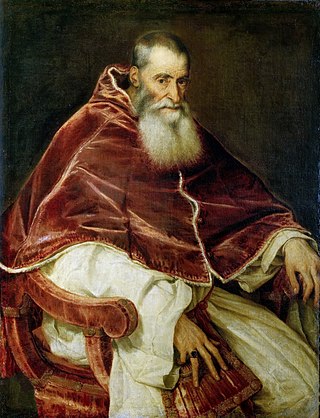
Pope Paul III was head of the Catholic Church and ruler of the Papal States from 13 October 1534 to his death, in November 1549.

Tiziano Vecellio, Latinized as Titianus, hence known in English as Titian, was an Italian Renaissance painter, the most important artist of Renaissance Venetian painting. He was born in Pieve di Cadore, near Belluno. During his lifetime he was often called da Cadore, 'from Cadore', taken from his native region.
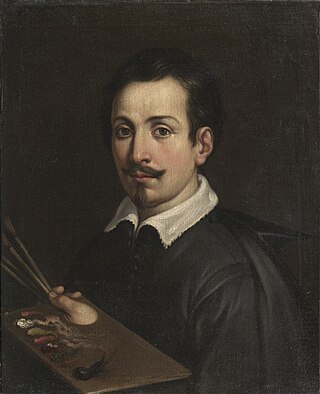
Guido Reni was an Italian Baroque painter, although his works showed a classical manner, similar to Simon Vouet, Nicolas Poussin, and Philippe de Champaigne. He painted primarily religious works, but also mythological and allegorical subjects. Active in Rome, Naples, and his native Bologna, he became the dominant figure in the Bolognese School that emerged under the influence of the Carracci.

Museo di Capodimonte is an art museum located in the Palace of Capodimonte, a grand Bourbon palazzo in Naples, Italy designed by Giovanni Antonio Medrano. The museum is the prime repository of Neapolitan painting and decorative art, with several important works from other Italian schools of painting, and some important ancient Roman sculptures. It is one of the largest museums in Italy. The museum was inaugurated in 1957.

Pope Paul III and His Grandsons is an oil on canvas painting by Titian, housed in the Museo di Capodimonte, Naples. It was commissioned by the Farnese family and painted during Titian's visit to Rome between autumn 1545 and June 1546. It depicts the scabrous relationship between Pope Paul III and his grandsons, Ottavio and Alessandro Farnese. Ottavio is shown in the act of kneeling, to his left; Alessandro, wearing a cardinal's dress, stands behind him to his right. The painting explores the effects of ageing and the manoeuvring behind succession; Paul was at the time in his late seventies and ruling in an uncertain political climate as Charles V, Holy Roman Emperor came into ascendancy.
Events from the year 1543 in art.

Leone Leoni was an Italian sculptor of international outlook who travelled in Italy, Germany, Austria, France, Spain and the Netherlands. Leoni is regarded as the finest of the Cinquecento medallists. He made his reputation in commissions he received from the Habsburg monarchs Charles V, Holy Roman Emperor and Philip II of Spain. His usual medium was bronze, although he also worked in marble and alabaster, carved gemstones and probably left some finished work in wax, as well as designing coins. He mainly produced portraits, and was repeatedly used by the Spanish, and also the Austrian, Habsburgs.
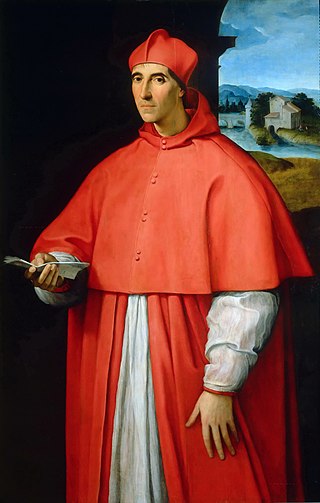
The Portrait of Cardinal Alessandro Farnese is a portrait of cardinal Alessandro Farnese by Raphael, executed circa 1509-1511.
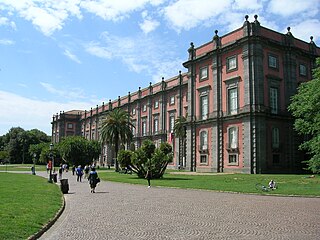
The Royal Palace of Capodimonte is a large palazzo in Naples, Italy. It was formerly the summer residence and hunting lodge of the Bourbon kings of the Two Sicilies, one of the two royal palaces in Naples. Today, the main building holds the main Neapolitan museum for paintings, and much other post-ancient art, in the National Museum of Capodimonte. This has the best collection of paintings from the distinct tradition of Neapolitan art, and also many works from the Farnese Collection.

The Venetian painter Titian and his workshop made at least six versions of the same composition showing Danaë, painted between about 1544 and the 1560s. The scene is based on the mythological princess Danaë, as – very briefly – recounted by the Roman poet Ovid, and at greater length by Boccaccio. She was isolated in a bronze tower following a prophecy that her firstborn would eventually kill her father. Although aware of the consequences, Danaë was seduced and became pregnant by Zeus, who, inflamed by lust, descended from Mount Olympus to seduce her in the form of a shower of gold.
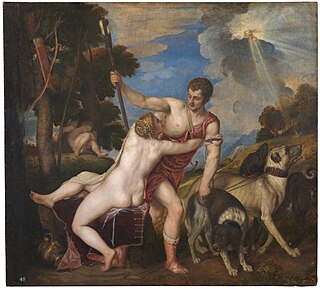
A composition of Venus and Adonis by the Venetian Renaissance artist Titian has been painted a number of times, by Titian himself, by his studio assistants and by others. In all there are some thirty versions that may date from the 16th century, the nudity of Venus undoubtedly accounting for this popularity. It is unclear which of the surviving versions, if any, is the original or prime version, and a matter of debate how much involvement Titian himself had with surviving versions. There is a precise date for only one version, that in the Prado in Madrid, which is documented in correspondence between Titian and Philip II of Spain in 1554. However, this appears to be a later repetition of a composition first painted a considerable time earlier, possibly as early as the 1520s.

Pedro Pacheco de Villena, also known as Pedro Pacheco Ladrón de Guevara, was a Spanish cardinal and viceroy of Naples. In Italian his name is spelled Pietro Pacecco. His nephew Francisco Pacheco de Toledo was also a cardinal.

Portrait of Lavinia Vecellio is an oil on wood portrait by Titian, from c. 1545. It is believed to depict his daughter Lavinia. It is held in the Museo di Capodimonte, in Naples.

Portrait of a Young Man Seated on a Carpet is a c. 1525–1527 oil on panel painting by Rosso Fiorentino, now in the National Museum of Capodimonte. The identity of its subject is unknown.

Portrait of Pier Luigi Farnese is a heavily-damaged oil on canvas painting of Pier Luigi Farnese, Duke of Parma by Titian, from 1546. It is now in Room 2 of the Museum of Capodimonte, in Naples.

Pope Paul III with a Nephew is an unfinished 1534 oil on slate portrait by Sebastiano del Piombo, now in the Galleria nazionale di Parma. The nephew's identity is unclear but the painting's presumed date suggests it may be Ottavio Farnese, whom Pope Paul III made Duke of Parma and Piacenza soon after the work's date

Penitent Magdalene is a c. 1550 oil on canvas painting by Titian, now in the Museo di Capodimonte in Naples.

Portrait of Cardinal Alessandro Farnese is a c. 1545–46 oil on canvas three-quarter-length portrait of Alessandro Farnese the Younger (1520–1589) by Titian. It is held in the Museo di Capodimonte, in Naples.

Portrait of Pope Paul III with Camauro is an oil on canvas painting by Titian, from c. 1545-1546. It is held in the Museo nazionale di Capodimonte, in Naples.

Portrait of Charles V or Portrait of a Man Wearing the Order of the Golden Fleece is an oil on canvas painting by Titian, from c. 1549. It is held now in the Museo di Capodimonte, in Naples.





















